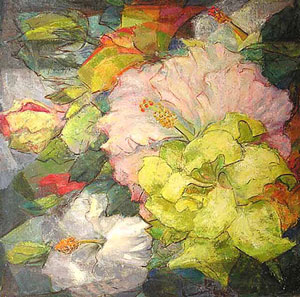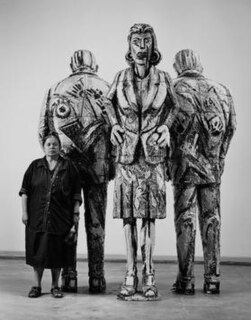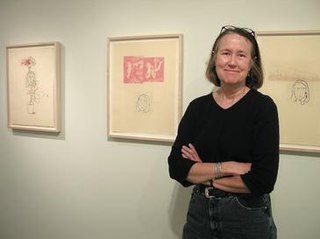Related Research Articles

San Francisco Art Institute (SFAI) is a private college of contemporary art in San Francisco, California. Founded in 1871, SFAI is one of the oldest art schools in the United States and the oldest west of the Mississippi River. Approximately 220 undergraduates and 112 graduate students are enrolled. The institution is accredited by the Western Association of Schools and Colleges (WASC) and the National Association of Schools of Art and Design (NASAD), and is a member of the Association of Independent Colleges of Art and Design (AICAD).

Richard Diebenkorn was an American painter and printmaker. His early work is associated with abstract expressionism and the Bay Area Figurative Movement of the 1950s and 1960s. In the late 1960s he began his extensive series of geometric, lyrical abstract paintings. Known as the Ocean Park paintings, these paintings were instrumental to his achievement of worldwide acclaim.

Jay DeFeo was a visual artist who first became celebrated in the 1950s as part of the spirited community of Beat artists, musicians, and poets in San Francisco. Best known for her monumental work The Rose, DeFeo produced courageously experimental works throughout her career, exhibiting what art critic Kenneth Baker called “fearlessness.”

California College of the Arts (CCA) is an art, design, architecture, and writing school with two campuses in California, one in San Francisco and one in Oakland. Founded in 1907, it enrolls approximately 1,225 undergraduates and 400 graduate students.

Nathan Oliveira was an American painter, printmaker, and sculptor, born in Oakland, California to immigrant Portuguese parents. Since the late 1950s, Oliveira has been the subject of nearly one hundred solo exhibitions, in addition to having been included in hundreds of group exhibitions in important museums and galleries worldwide. He taught studio art for several decades in California, beginning in the early 1950s, when he taught at the California College of Arts and Crafts in Oakland. After serving as a Visiting Artist at several universities, he became a Professor of Studio Art at Stanford University.
Jean Conner née Sandstedt is an American artist.
Wally Bill Hedrick was a seminal American artist in the 1950s California counterculture, gallerist, and educator who came to prominence in the early 1960s. Hedrick’s contributions to art include pioneering artworks in psychedelic light art, mechanical kinetic sculpture, junk/assemblage sculpture, Pop Art, and (California) Funk Art. Later in his life, he was a recognized forerunner in Happenings, Conceptual Art, Bad Painting, Neo-Expressionism, and image appropriation. Hedrick was also a key figure in the first important public manifestation of the Beat Generation when he helped to organize the Six Gallery Reading, and created the first artistic denunciation of American foreign policy in Vietnam. Wally Hedrick was known as an “idea artist” long before the label “conceptual art” entered the art world, and experimented with innovative use of language in art, at times resorting to puns.

Shirley Ximena Hopper Russell, also known as Shirley Marie Russell, was an American artist best known for her paintings of Hawaii and her still lifes of Hawaiian flowers. She was born Shirley Ximena Hopper in Del Rey, California, in 1886. She graduated in 1907 from Stanford University, where she discovered art. Shirley married Lawrence Russell, an engineer, in 1909. When he died in 1912, she began teaching in Palo Alto, and dabbling in painting. In 1921, she and her son came to Hawaii for a visit and decided to stay. She studied under Hawaiian artist Lionel Walden during the 1920s and traveling to Europe several times to further her art education. She studied in Paris during the 1930s and the cubist influence can be seen in a number of her works. She taught art at President William McKinley High School in Honolulu for more than 20 years. Around 1935-1936, the Japanese publisher Watanabe Shozaburo (1885–1962) published more than several woodblock prints she designed. The majority of these prints depict colorful and detailed tropical flowers, while at least one print, Carmel Mission, is a California landscape.

Frank Lobdell was an American painter, often associated with the Bay Area Figurative Movement and Bay Area Abstract Expressionism.

Viola Frey was an American artist working in sculpture, painting and drawing, and professor emerita at California College of the Arts. She lived and worked in the San Francisco Bay Area and was renowned for her larger-than-life, colorfully glazed clay sculptures of men and women, which expanded the traditional boundaries of ceramic sculpture.
Richard Irving Bowman (1918–2001) was an abstract painter who worked primarily in the San Francisco Bay Area. He painted in an idiosyncratic style inspired by transcendental visions of nature, exposure to surrealism and investigations into sub-atomic physics. He is considered one of the first fine artists to employ fluorescent paint, which he maintained embodied sub-atomic life energy, beginning in the early 1950s.
Kay Sekimachi is an American fiber artist and weaver, best known for her three-dimensional woven monofilament hangings as well as her intricate baskets and bowls.
Terry Acebo Davis is a Filipino American artist and nurse based in the San Francisco Bay Area. Her art is thematically linked to her family and her origins as a Filipino American.

Helen Katharine Forbes was a Californian artist and arts educator specializing in etching, murals and painting. She is best known for western landscapes, portrait paintings, and her murals with the Treasury Section of Fine Arts and Work Progress Administration (WPA). Forbes was skilled in painting in oil, watercolor, and egg tempera. She painted landscapes of Mexico, Mono Lake and the Sierras in the 1920s, desert scenes of Death Valley in the 1930s, and portraits and still-lifes.
Amy Ellingson is an American contemporary abstract painter. She is a native of the San Francisco Bay Area and currently lives and works in Santa Fe, New Mexico.
Joe Doyle was an American artist. He is one of the original painters in the style, abstract illusionism, of the 1970s and has since evolved his style using computerized technologies to create Digital art.

Barbara Tisserat (1951–2017) was an American artist and lithographer born in Denver, Colorado. She taught lithography at Virginia Commonwealth University's School of the Arts. She was a member of One/Off Printmakers and also taught at the Virginia Museum of Fine Arts Robinson House lithography workshop with Marilyn Bevilacqua. She was active with the Richmond Printmaking Workshop and served on the Advisory Board of Studio Two-Three in Richmond, Virginia. She was a member of the Summer 2007 graphics faculty at Haystack Mountain School of Crafts and was a visiting artist and lecturer in the Lyceum program at Emory and Henry College.
Fred Thomas Martin (1927) is an American artist, writer and former arts administrator and educator who has been active in the San Francisco Bay Area art scene since the late 1940s. He was a driving force of the Bay Area art scene from the mid 1950s until his recent retirement from the San Francisco Art Institute. In addition to his artistic practice, Martin is widely known for his work as a longtime administrator and Professor Emeritus at the San Francisco Art Institute (SFAI).
Elizabeth Sawyer Norton (1887–1985) was an American artist, known for her bronze sculptures, paintings, and printmaking. The subject of her work often featured animals, landscapes and/or portraits. She lived in Palo Alto, California, from 1919 until her death in 1985.
Dominic L. Di Mare is an American artist and craftsperson, known for his weaving, abstract mixed-media sculpture, watercolor paintings, cast paper art, and fiber art. His work touches on themes of personal spirituality. He is based in Tiburon, California.
References
- ↑ Goldsmith, Aleza (24 August 2001). "Late-blooming artist Gertrude Bleiberg dies in Palo Alto". Jweekly.com. Retrieved 23 July 2015.
- ↑ Defying Gravity. Emmis Books. March 2005. ISBN 9781578602087 . Retrieved 29 July 2015.
- ↑ Bleiberg, Gertrude. Gertrude Bleiberg: Retrospective 1970-1996.